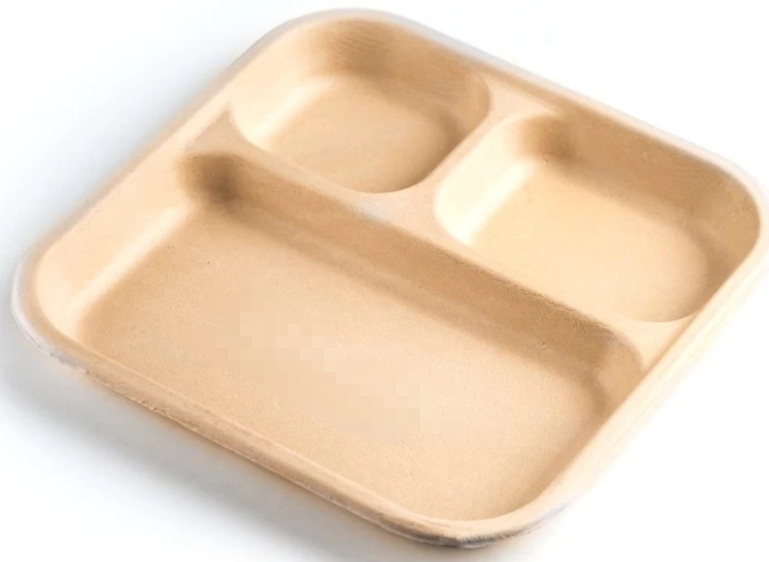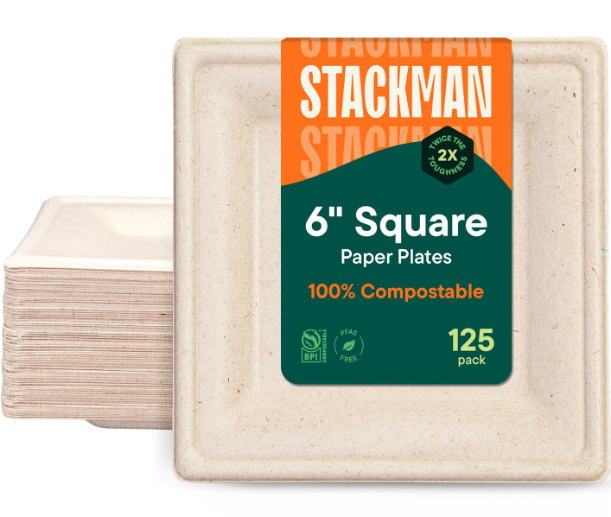
Content Menu
● Introduction to Sugarcane Disposable Plates
>> Production Process
● Environmental Benefits of Sugarcane Disposable Plates
>> Biodegradability and Compostability
>> Renewable Resource
>> Versatility and Durability
● Comparison with Plastic and Paper Plates
>> Plastic Plates
>> Paper Plates
● Health and Safety Benefits
● Cost-Effectiveness and Accessibility
● Market Growth and Economic Impact
● Stylish and Sustainable
● Conclusion
● Frequently Asked Questions
>> 1. What are sugarcane disposable plates made of?
>> 2. How long do sugarcane plates take to decompose?
>> 3. Are sugarcane plates safe for microwave use?
>> 4. Do sugarcane plates contain harmful chemicals?
>> 5. Can sugarcane plates be reused?
● Citations:
In recent years, the world has seen a significant shift towards eco-friendly products, especially in the realm of disposable tableware. Among these alternatives, sugarcane disposable plates have gained considerable attention due to their biodegradable and compostable nature. This article delves into the eco-friendliness of sugarcane plates, exploring their production process, benefits, and how they compare to traditional plastic and paper plates.

Introduction to Sugarcane Disposable Plates
Sugarcane disposable plates are made from bagasse, the fibrous residue left after extracting juice from sugarcane stalks. Traditionally considered waste, bagasse is now repurposed to create various eco-friendly products, including plates, bowls, and containers. These plates are not only biodegradable and compostable but also offer a sustainable alternative to plastic and paper plates.
Production Process
The production of sugarcane plates involves several steps:
1. Sugarcane Juice Extraction: The first step is extracting juice from sugarcane stalks for sugar production.
2. Bagasse Collection: The fibrous residue, or bagasse, is collected and processed.
3. Pulping and Molding: Bagasse is turned into pulp, mixed with water, and molded into the desired shape using high heat and pressure.
The transformation of bagasse into usable pulp is a crucial step in the production of bagasse plates. This process involves several key stages, each aimed at extracting and purifying the fibers from the sugarcane residue. These fibers form the basis of the final product, ensuring its strength and biodegradability.
Initially, the collected bagasse undergoes preliminary cleaning to remove any residual sugar and extraneous matter. This step is crucial to ensure that the following pulping process is efficient and yields superior pulp. In the pulping stage, the cleaned bagasse is mixed with water and subjected to high pressure and temperature in a pulper. This mechanical action breaks down the bagasse into its fibrous components, resulting in a slurry called "bagasse pulp". This pulp contains a mix of cellulose fibers, hemicellulose, and lignin.
The next critical step is "bleaching", which involves treating the pulp with chemicals to remove the lignin and other impurities. Bleaching not only whitens the pulp but also enhances its suitability for molding into plates. Generally, a combination of chlorine-free agents such as hydrogen peroxide or oxygen is used to achieve the desired level of whiteness and purity without compromising the environment.
During this process, strict quality control measures are implemented to monitor the consistency and purity of the pulp. By ensuring that the pulp meets specific standards, producers like "Eco-products" and "World Centric" can produce excellent, green bagasse plates that meet market needs for sustainable disposable products.
The process of "molding and shaping" is vital in transforming bagasse pulp into useful and aesthetically pleasing plates. Once the bagasse pulp is ready and bleached, it is prepared to be molded into plates. This step involves using specialized molds that define the shape and size of the final product.
Firstly, the bagasse pulp is poured into molds designed to create the desired plate shape. These molds are often made of metal or high-density plastic, ensuring they can withstand the high pressure and heat applied during the process. The pulp is evenly distributed within the mold to ensure consistency in thickness and shape.
Environmental Benefits of Sugarcane Disposable Plates
Biodegradability and Compostability
Sugarcane plates are 100% biodegradable and compostable, breaking down naturally within a few months in a composting environment. This reduces landfill waste and returns nutrients to the soil, contributing to environmental sustainability. In industrial composting facilities, sugarcane plates typically decompose within 60 to 90 days. Home composting may take longer, but the plates will still break down much faster than petroleum-based plastics[1].
Renewable Resource
Sugarcane is a rapidly renewable resource, with crops growing to maturity in about 12 months. This makes sugarcane plates a sustainable alternative to traditional disposable tableware made from non-renewable resources like plastic. The use of sugarcane plates not only aids in waste management by reducing landfill burden but also contributes to a circular economy by turning agricultural waste into useful products[1].
Versatility and Durability
Sugarcane plates are versatile and durable, capable of holding hot and cold foods without leaking or losing shape. They are microwave-safe and suitable for various dining situations, from casual picnics to formal events. However, they may not be as durable as plastic plates, especially for heavy or sharp foods, and can become soggy if not treated to be water-resistant[5].

Comparison with Plastic and Paper Plates
Plastic Plates
- Non-Biodegradable: Plastic plates can take hundreds of years to decompose, contributing to pollution and harming ecosystems.
- Chemical Leaching: Plastic can leach harmful chemicals like BPA and phthalates into food, posing health risks.
Paper Plates
- Resource Consumption: Paper plates often require virgin tree pulp, contributing to deforestation.
- Less Durable: Paper plates are generally less sturdy than sugarcane plates and may become soggy with wet foods.
Health and Safety Benefits
Sugarcane plates are free from toxic chemicals, making them a safer option for food use compared to plastic plates. They are also hypoallergenic and non-toxic, suitable for sensitive environments like schools and hospitals. Unlike plastic products, which often contain harmful chemicals such as bisphenol A (BPA), sugarcane bagasse plates do not release toxic substances when in contact with food or beverages[8].
Cost-Effectiveness and Accessibility
While sugarcane plates might be slightly more expensive than plastic plates, they offer long-term environmental benefits and are becoming increasingly accessible for both individuals and businesses. The cost-effectiveness of sugarcane plates is also influenced by the low price of raw materials, as bagasse is a readily available byproduct of sugar production[3].
Market Growth and Economic Impact
The market for sugarcane bagasse biodegradable disposable tableware is experiencing significant growth, driven by increasing awareness and preference for eco-friendly alternatives. In India, for example, this market has seen substantial expansion, with projections indicating continued growth over the coming years[4]. The adoption of sugarcane bagasse tableware not only reduces plastic pollution but also supports sustainable agricultural practices and creates employment opportunities.
Stylish and Sustainable
Sugarcane plates combine style with sustainability, offering a natural texture and earthy appearance that adds elegance to any table setting. They are available in various shapes and sizes, making them suitable for different serving needs. Both sugarcane plates and palm leaf plates emerge as frontrunners in terms of eco-friendliness, biodegradability, and aesthetic appeal[6].
Conclusion
Sugarcane disposable plates are indeed eco-friendly, offering a sustainable alternative to traditional plastic and paper plates. Their biodegradable and compostable nature reduces waste, while their production utilizes renewable resources. As consumers increasingly embrace eco-conscious practices, sugarcane plates stand out as a beacon of sustainability in the packaging revolution.

Frequently Asked Questions
1. What are sugarcane disposable plates made of?
Sugarcane plates are made from bagasse, the fibrous residue left after extracting juice from sugarcane stalks. This material is biodegradable and compostable.
2. How long do sugarcane plates take to decompose?
Sugarcane plates typically decompose within 60 to 90 days in industrial composting facilities. Home composting may take longer, but the plates will still break down much faster than petroleum-based plastics[1].
3. Are sugarcane plates safe for microwave use?
Yes, sugarcane plates are generally microwave-safe, capable of withstanding temperatures up to 220°F. However, it's advisable to check specific product certifications.
4. Do sugarcane plates contain harmful chemicals?
No, sugarcane plates are free from toxic chemicals like BPA and phthalates, making them a safer choice for food use compared to plastic plates[1].
5. Can sugarcane plates be reused?
While sugarcane plates are designed for single use, they can be wiped clean and reused if not heavily soiled. However, repeated washing is not recommended.
Citations:
[1] https://diyecobox.com/are-sugarcane-plates-safe-to-use/
[2] https://diyecobox.com/how-bagasse-plates-are-made-step-by-step-process/
[3] https://www.bioleaderpack.com/what-are-the-characteristics-advantages-and-disadvantages-and-application-scope-of-sugarcane-bagasse-tableware/
[4] https://www.mitconindia.com/blogs/exploring-the-indian-market-of-sugarcane-bagasse-biodegradable-disposable-tableware/
[5] https://www.bioleaderpack.com/comparison-of-strength-and-durability-between-disposable-sugarcane-bagasse-tableware-and-plastic-tableware/
[6] https://www.craftecopack.com/blog/the-eco-friendly-battle-sugarcane-plates-vs-palm-leaf-plates-vs-paper-plates_b27
[7] https://worldpapermill.com/disposable-plates-from-sugarcane-waste/
[8] https://www.quitplastic.in/post/sugarcane-bagasse-plates-the-best-alternative-for-plastic
[9] https://www.accessnewswire.com/newsroom/en/industrial-and-manufacturing/disposable-plates-market-to-expand-at-36-cagr-through-2035-driven-by-fo-983798
[10] https://atyourservous.com/bagasse-vs-polystyrene/
[11] https://www.quitplastic.in/post/comparing-sugarcane-bagasse-vs-plastic-and-paper-single-use-disposables-a-sustainable-showdown
[12] https://www.craftecopack.com/blog/from-raw-material-to-bagasse-plates-the-complete-manufacturing-process_b23
[13] https://gangxuan-ecotech.com/what-are-the-advantages-and-disadvantages-of-bagasse-plates/
[14] https://www.gminsights.com/industry-analysis/disposable-plates-market
[15] https://www.sumkoka.com/bagasse-vs-paper-products.html
[16] https://redwingbioware.com/top-benefits-of-using-biodegradable-sugarcane-bagasse-plates/
[17] https://chuk.in/how-bagasse-plates-are-made/
[18] https://www.forbestpackaging.com/sugarcane-paper/
[19] https://www.businessresearchinsights.com/market-reports/sugarcane-bagasse-based-disposable-tableware-market-120796
[20] https://www.linkedin.com/pulse/comparison-bioplastic-bagasse-based-products-use-foodware-vembadi

















